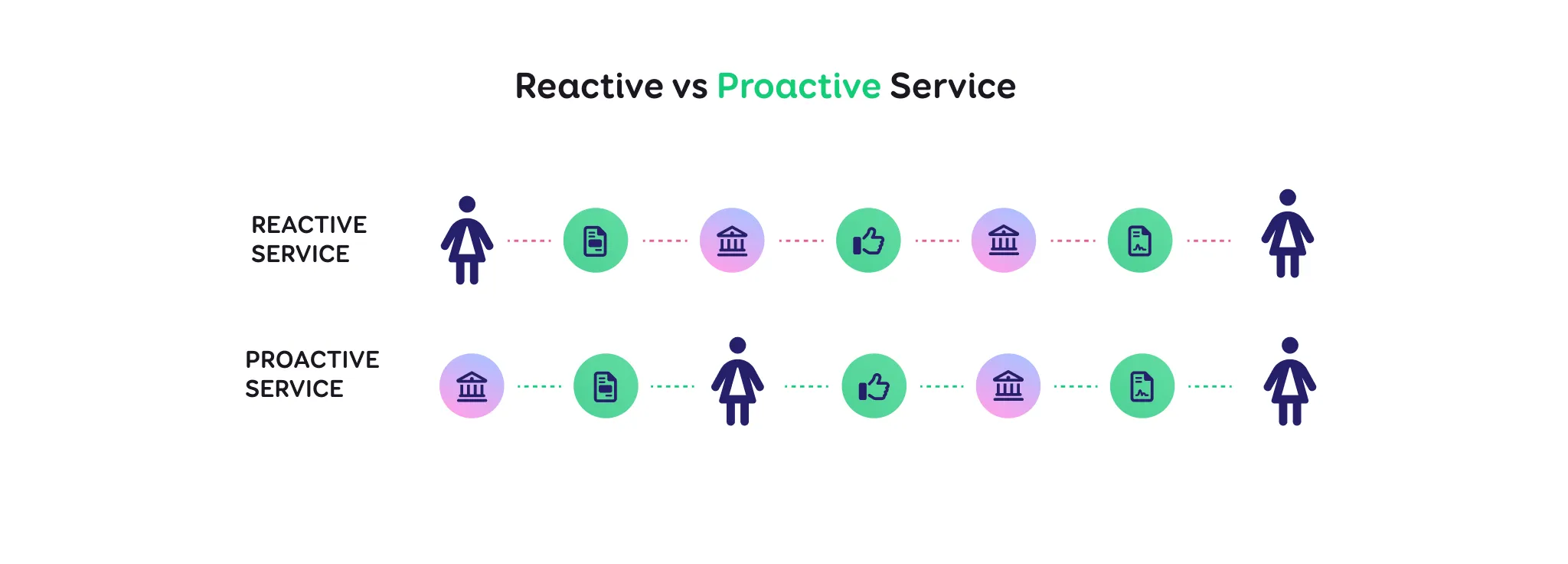Event Based Services Analysis
Crafting the Vision and Strategy for Event-Based Services
Project Overview
In cooperation with the Ministry of Economic Affairs and Communications and PricewaterhouseCoopers Ltd, we carried out a vision project with the goal of creating a concept for the Estonian government's event based services and understanding the content and extent of necessary development work.
In the project, we studied five key life events where people need to use different online services from the government. We ended up with a report and some sample versions of what the services could look like. These materials will help guide the development of these services in the future.
The first event services to be implemented are those for childbirth and marriage, which are already available for use. Information about all the soon-to-be fully available event services can be found on the homepage of the Estonian government portal, eesti.ee.

Public services must be current, relevant, easily accessible, and user-friendly.
Every individual has interactions with the government throughout their life. These interactions depend on the person's age, field of activity, life events, and other specific characteristics. Each interaction is driven by a specific need, right, or obligation.
In the current evolving information society, the e-government is oriented towards the individual, not the other way around. Therefore, solutions should be created considering people's needs, so that public services support individuals in achieving their objectives.
The key term in the Event Services project is "proactivity" – this means that for accessing services, individuals do not have to search for them within the government's systems. Instead, these services are proactively offered to them by the government at the right time and in the right sequence.

Some services arise from information already known to the state, such as an individual reaching adulthood, becoming pregnant, or reaching retirement age. In other cases, the individual informs the state about their need for services, such as plans to marry.
The Estonian government portal, eesti.ee, consolidates various event services that a person might require throughout their life. This means the portal presents generalised information about all the event services one might use in their lifetime, including attending general education schools, fulfilling military service obligations, having a child, getting married, obtaining a driving licence, etc.
The portal recognises the user's position in the timeline of the event service and can guide the user to appropriate state self-service environments for accessing sub-services.
Users of the event service experience their progression through the service steps as a single process. However, since one service may involve using several state services, eesti.ee seamlessly connects with other state service systems at the appropriate time, enabling the necessary data exchange. Therefore, an event service comprises a series of sub-services provided by various agencies.
Detailed information about the sub-services that constitute the event service is not displayed on the central information portal, nor are actions related to consuming sub-services performed there - these functions are handled by various e-self-service environments. The portal's primary aim is to notify users about the need to use sub-services.
The event service streamlines individuals' communication with the state
The event service represents a key direction in the development of e-government, with the aim of simplifying the interaction between private individuals, businesses, and the government. The philosophy of event services is to proactively provide e-government services when there is a need, ensuring that people don’t have to worry about keeping up with all their obligations to the state or being aware of all their rights.
By the end of 2023, European Union member states are required to fully digitise a number of cross-border public services. These include 21 public services, categorised under seven life events: birth, residency, education, employment, moving, retirement, and starting, managing, or closing a business.
Project Stages
In the project, we partnered with PricewaterhouseCoopers Ltd, who carried out extensive preliminary work for analysing the background of event services and learning from best practices.
For inspiration, we examined the experiences of the D9 group, a coalition of nine countries with advanced e-governance. Besides Estonia, the D9 group in 2019, when we started the project, included Israel, New Zealand, South Korea, Canada, Mexico, Uruguay, and Portugal.
Our role in the project involved conducting analyses of five chosen event services: marriage, fulfilling military service obligations, having a child, managing the death of a close relative, and retirement.
We included all sub-services related to these predictable life events in our scope, excluding exceptions and convenience services from the analysis (an exception is included only if there is a specific agreement to do so).
As-is Description
We began our event services analysis by describing the current (as-is) situation. Our aim was to understand the processes for delivering each service at that time and identify any potential problem areas.
In our descriptions of each event service's current state, we focused on important user groups related to the service, including statistics and trends.
We detailed the services as they were and analysed them in the context of event services, considering the overall business and information processes, and how data moves between the roles involved in the event service and the information systems in use. We highlighted the main barriers and issues in the workflows and established metrics for the overall event service.
To-be Description
The findings from the current (as-is) situation mapping served as the foundation for the future-oriented (to-be) analysis, which outlines the envisioned future of the service. Consequently, we plan an event service that enables users to smoothly access all services linked to a specific life event.
In designing the future (to-be) service, we centered on the objectives, needs, and expectations of the users, and aimed to address the problems identified in the service's present state.
The future service was designed to be as proactive as possible. This means minimising the number of actions required by the user and primarily having the state initiate the delivery of the service and its subcomponents.

The first step in the to-be analysis involved understanding the needs and goals of the end-users. We included representatives from the institutions providing the services, as well as the end-users themselves in the to-be analysis. We refined the description of the service's future vision based on their feedback.
As a result, we created personas. Taking these described personas into account, we designed the service's to-be vision, or the potential future solution. To demonstrate this vision, we developed a prototype, which allows us to gather feedback from the end-users on the planned service.
To-be Analysis Stages
1. Personas
A persona is a summary of a type of end-user with similar goals. A persona is a fictional character that represents the attributes of real end-users. Here, an end-user refers to a person who consumes the event service, rather than being involved in its provision.
The objectives of creating personas are:
- to form a common vision among project stakeholders about the user for whom the system is being created.
- to make design-related decisions during the creation of prototypes, based on these personas.
- to prioritize the content of the system and highlight functionalities important to different user groups.
In creating personas, we based them on the user groups of the five agreed-upon event services. In describing a persona, we mapped the needs, goals, expectations, pain points, and behavioral patterns of the selected user group in relation to the specific event service.
The information for creating personas was obtained from representatives of the institutions providing the services, who interact with end-users on a daily basis. During the project, we described at least one persona for each of the five event services selected for to-be analysis.
2. Description of the To-be Vision
We developed the to-be vision or the potential future solution of the service according to the expectations and objectives of the personas. The description of the to-be situation for each event service includes the following essential information:
Main Changes
We described the fundamental changes in the future solution of the event service compared to the current situation.
Beginning and the End of Service
We identified the event that initiates the event service and the criterion that concludes it.
Initiating Event - This is the event that, in the future vision, starts the provision of the entire event service. We included the name and a brief description of the activity. Roles involved and the information system used in this event were also outlined.
Concluding Criterion - This refers to the feature that, in the future vision, indicates the completion of the event service. We described the situation where all sub-services within the scope of our analysis have been fully delivered to the user. We highlighted the concluding activity or activities, which could be executed by both information systems and roles. Our approach was based on a predictable flow, without considering exceptions.
List of Sub-Services
We provided a list of sub-services that will be included in the event service from a future perspective. In this list, we considered the future plans and changes in the service roster from the sub-service owners. This list offers an overview of the sub-services that are taken into account in forming the future vision of the event service.
As we assessed the necessity of each sub-service within the event service during our analysis, we also made suggestions for discontinuing unnecessary sub-services or for adding new ones. Therefore, the list of sub-services in the future vision might differ from the current list of sub-services at that time. We also highlighted sub-services that are related to the specific life event but fall outside the scope of this project's analysis.
User Groups
We identified a list of key user groups for the future solution of the event service and the number of users. We forecasted the dynamics of these user groups in the future.
The groups were formed and statistics presented for the event service as a whole; we did not describe specific user groups for sub-services or their numerical indicators. The input for describing these user groups was based on information received from the providers of the sub-services.
Information Service Description
We described how vital information related to the event service and its sub-services is conveyed to users.
Business and Information Processes
We outlined how the delivery process of the event service as a whole could operate in the future. We described business and information processes for each sub-service, highlighting the main activities of each sub-service, the roles involved, the information systems used, and the key inputs and outputs of each sub-service that are essential for other sub-services.
Regarding information systems, we distinguished between primary systems, where the main operations of sub-services are carried out, and supporting systems, which are referred to for data verification or supplementation, either manually or through an interface.
The aim was to describe the processes of the event service as a whole, focusing on the sequence of service provision, data movement between sub-services, and the roles in these activities, which are necessary for linking sub-services or initiating and concluding them. We did not detail the internal activities of the sub-services.
Data Flows
We described the future perspective of the information systems related to the event service and the data exchange between them.
Development Needs
We provided a list of necessary information system developments required to deliver the event service in accordance with the described future vision.
New Work Arrangement for Sub-Service Providers
We outlined how the management of the event service could be conducted in the future. We explained the development and management model of event services in the context of a specific event service, presenting the placement of institutions involved in service provision within the RACI (Responsible, Accountable, Consulted, Informed) model.
Legal Analysis
We presented a list of legal acts related to the event service and referenced paragraphs that may conflict with the concepts of event services and proactiveness. We described the identified obstacles and provided recommendations. The legal analysis was provided as an Excel file attached to the report.
Risks
We described the main risks associated with the future solution of the event service and proposed measures to mitigate these risks. Risks and countermeasures were grouped by themes and presented in a table format.
We identified risks in collaboration with the owners of the sub-services (for example, civil registry offices and Population Registry) during a workshop-style meeting.
Metrics
We suggested to the client the adoption of a unified system of metrics for event services and the implementation of similar measurements for all event services. A unified approach to event services enables comparison between services and ensures consistency across them.
The process of measurement should be consistently automated and managed by the information system used for service delivery. Therefore, it is essential to incorporate the capability for automated measurements into the developed information system.
To test the vision, we created interactive prototypes for all five event services.
For the purposes of demonstrating the user interfaces, we developed wireframe-style prototypes that align with user expectations and the business needs of the organisation responsible for the event service.
The objectives of the prototypes were to:
- to clarify the concepts for providing event services;
- to enable quick feedback;
- to recognize and resolve issues prior to the commencement of system development.
For each agreed-upon event service user interface, we prototyped up to 7 views, covering the system's essential functionalities and the event service's main user journey from the end-user perspective. We focused on demonstrating the event service as a whole and did not delve into the details of sub-service processes.
In this project scope, it was important to understand the main workflow and key decision points. The goal of the prototype was to help validate the concepts created with users and understand what questions and concerns the designed event services raise.
The created prototypes are interactive, allowing functionalities to be tested on end-users. Testing enables the identification and resolution of usability issues, such as areas in the user interface or service logic that are uncomfortable or seem illogical to users.
As part of the project, we asked users to complete 5-7 test tasks. Testing was conducted individually, with each session lasting up to an hour, and was recorded as audio and screen captures. If necessary, we clarified users' needs during the testing session by asking additional questions. In total, we conducted 15 usability tests, meaning we tested each event service user interface prototype on 3 end-users.
As a result of testing, we identified usability issues and made corresponding changes to the prototypes where necessary.
The deliverables for the Ministry of Social Affairs Included
We comprehensively analysed five event services, examining both the current operational state (as-is) and the proposed comprehensive service model (to-be), depicting the desired future state. These services included marriage, fulfilling military service obligations, childbirth, dealing with the death of a loved one, and retirement.
As a result of our work, we delivered an analysis document along with interactive prototypes to the Ministry of Economic Affairs and Communications.
The project's outcomes are now visible through event services accessible and consumable from the homepage of the eesti.ee government portal. Building on our analysis and prototypes, development activities continue with other partners of the Ministry of Economic Affairs and Communications, and more event services are gradually being added to the eesti.ee portal.
Effective cooperation with the client is key to achieving successful results
At Trinidad Wiseman, we have been involved in projects for both the public and private sectors for over 18 years. Our projects are evenly split between the private and public sectors, and our extensive experience confirms that effective collaboration with each client is vital for project implementation and outcomes. Only with such an approach can we develop services that genuinely meet the desires and needs of our clients.
Human-centredness has been fundamental to Trinidad Wiseman since its inception, both in our projects and in our work culture. We are pleased that in the event services project, the Ministry of Economic Affairs and Communications was highly motivated as a client to invest in human-centred design because they genuinely want to improve and streamline the lives of Estonian citizens.
The Ministry of Economic Affairs and Communications had conducted thorough preparatory work and had a clear vision of the future of Estonian e-services. They were deeply involved in the project - always planning time and actively participating in workshops, brainstorming, and providing swift and valuable feedback.
s the service provider, we are pleased to have helped the Ministry of Economic Affairs and Communications directly improve the lives of Estonian citizens. On one hand, we helped the government take a significant step towards meeting the obligations set by the European Union for the development of e-services. But more importantly, the entire process focused on end-users, making communication with the state even simpler, smoother, and more enjoyable for them.

